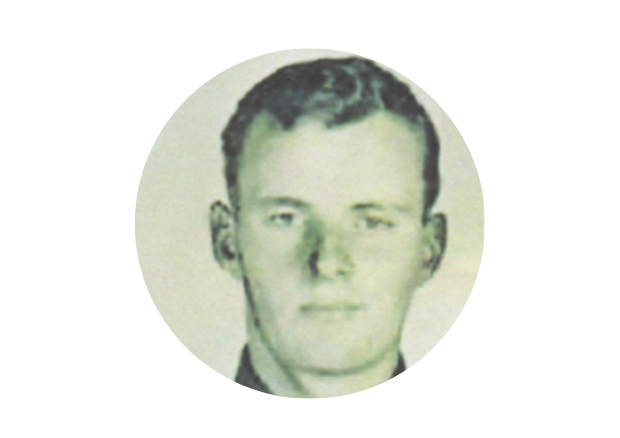Anthony McDiarmid
Ship name / Flight number: Morton Bay
Arrival Date: 1939
For the Fallen
By David Coleman, QF '63
Over the years, I’ve attended many Anzac Day and Armistice Day (Remembrance Sunday) commemorations and stood in silence as the Ode was recited. When visiting country towns, I make a point of stopping at the local war memorials and reading the names of those inscribed.
One such memorial is the Honour Board at Karmsley Training Farm, erected by the Members of the Big Brother Movement to commemorate those Little Brothers known to have lost their lives while serving in the Australian Armed Services during World War II.
There are seventeen names on the board.
McDiarmid, Anthony (AIF)
21 July 1921 -1 July 1942
The BBM records for Tony indicate his date of birth as 21 July 1921 but no place of birth or home address. His British address on his arrival was C/o Watkins & Pulleyn of 14 Grays Inn Square London. His father’s name is not listed only that he was a solicitor. His schooling is indicated as “privately tutored”.
Tony arrived in Australia on 10 August 1939 aboard the Moreton Bay. The ship’s manifest lists his occupation as a groom and his last address in England: West Farm, Altarnun Cornwall.
He spent time at the Scheyville Farm where he was placed with T.M. Crockett, a dairy farmer at Rolands Creek, New South Wales and was paid 15 shillings (15/-) per week.
Using the name Anthony Tony McDiarmid, he enlisted in the 2nd Australian Imperial Force (2ndAIF) at Paddington NSW on 12 June 1940. His enlistment documents say he was born on 21 March 1919 at Murwillumbah, NSW, the son of Arthur Hallam and Esther McDiarmid. Anthony had written his place of birth as Bury, Sussex, and changed it to Murwillumbah NSW.
Tony McDiarmid was in fact born on the 21 July 1921 at Bury Manor, Bury, Sussex the son of Arthur Hallam McDiarmid and Esther Rogers. His next of kin was Arthur H. McDiarmid, his father who lived in Altarnun Cornwall in 1940.
After training with the 2nd R.R Battalion in Sydney in May 1941 he was posted to the newly formed No 1 Independent Company, one of 12 independent or commando companies. With the threat of war looming, in July 1941 a small Australian commando force, the 1 Independent Company comprising only of 250 men embarked on the Australian steamship HMAT “Zealandia” for Kavieng, New Ireland in the Territory of New Guinea disembarking on 29 July. In the event of an invasion, 1 Independent Company’s role would be to resist the enemy long enough so that the airfields and other military installations could be destroyed. The company was then to withdraw further south, where it would wage guerilla war.
On 21 January 1942 about 60 Japanese aircraft attacked Kavieng. As Japanese troops reached the airfield, there was fighting as the Australians destroyed the airfield and supply dump. Hopelessly outnumbered, the commandos still fighting around Kavieng fell back to Sook. Not all of them made it. Some were captured. Anthony was probably with the bulk of the Company who escaped overland to Kaut on the south coast and boarded the schooner “Induna Star” the company’s only means of escape on the 29 January. They made their way along the coast of New Ireland heading to Rabaul. When the ship learned that Rabaul had fallen, the group decided to sail for Port Moresby, but the ship was sighted by a Japanese aircraft which bombed and strafed, causing considerable damage to the vessel, as destroying one of its lifeboats and caused several casualties. The Japanese instructed the ship to sail to Rabaul escorted by Japanese aircraft until it was met by a Japanese destroyer and taken under tow. The Australians were transferred to the destroyer and became prisoners of war.
On 22 June 1942 an estimated 845 POWs, members of the No 1 Independent Company, 2/22 Battalion (including Anthony McDiarmid), members of Lark Force whose officers were taken to Japan where they remained in captivity for the remainder of the war, 209 civilian officials of the New Guinea Administration and missionaries captured by the Japanese forces embarked from Rabaul aboard the Japanese transport ship MV Montevideo Maru.
The unmarked POW ship was proceeding without escort to the Chinese Island of Hainan, when it was sighted by the American submarine the USS Sturgeon near the Philippine coast on 30 June. Not knowing that the ship was carrying POWs, the Sturgeon fired four torpedoes which sank the Montevideo Maru on 1 July 1942 in less than 11 minutes. Anthony McDiarmid drowned when the ship went down. His body was never recovered.
Unaware of the ship’s loss, the families of those aboard continued to send letters in the belief that their loved ones were being held as prisoners of war. It was not until after the war that they discovered the fate of those lost. Tony’s mother, Esther, claimed his war medals giving his age as 21.
Little Brother NX31697 Private Anthony (Tony) McDiarmid died aged 23 years of No 1 Independent Company is commemorated on the Rabaul Memorial Panel 13, Rabaul Memorial, Rabaul, East New Britain, Papua New Guinea and The Australian Commando Memorial, Australia War Memorial Roll of Honour, Ballarat Australian Ex-Prisoners of War Memorial, Rabaul Memorial, Rabaul Montevideo Maru Memorial, and the Honour Board at Karmsley Farm.
References:
Birth Registration “England and Wales Birth Index”
Gillon, Geoffrey (contributed by), Virtual War Memorial
https://vwma.org.au/explore/people/638479
NationalArchives
https://recordsearch.naa.gov.au/SearchNRetrieve/Interface/ViewImage.aspx?B=4859681
The Australian Ex-Prisoners of War Memorial
https://www.powmemorialballarat.com.au/prisoners of war/mcdiarmid-anthony/
Wikitree



